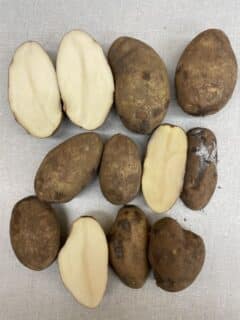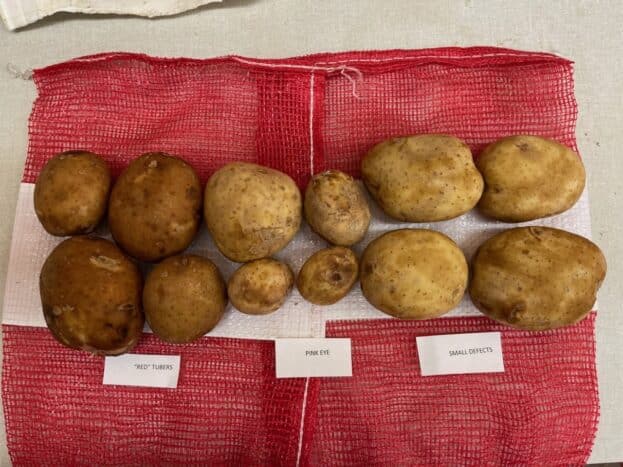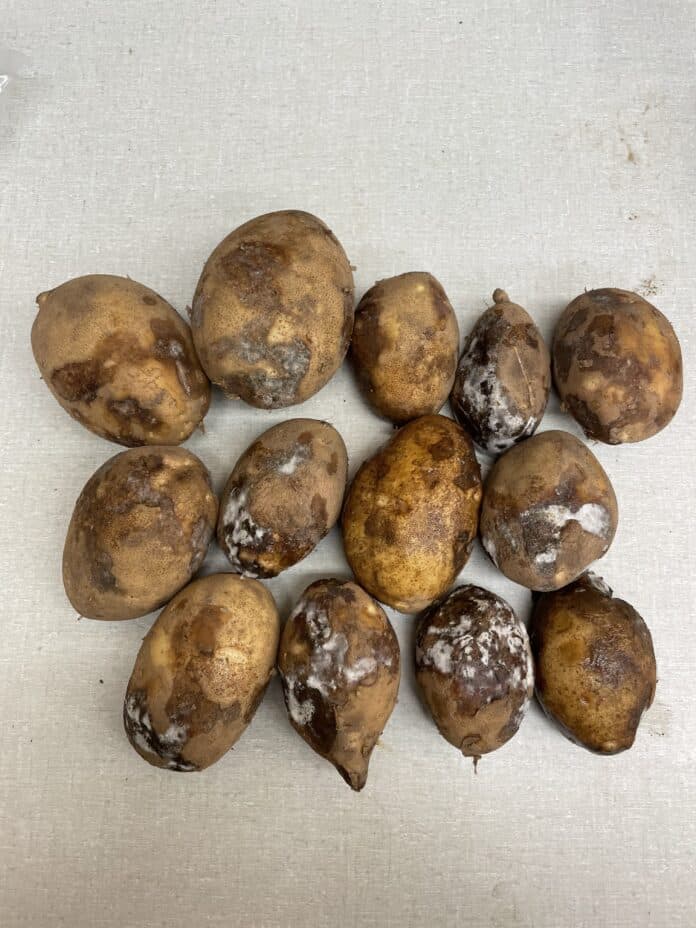A new potato disease called rubbery rot is popping up in potato storages across North America.
Kasia Duellman is used to growers’ bringing in diseased tubers from potato storages to her University of Idaho (U of I) lab and asking what’s wrong with them. But she found herself stumped one day in November 2020.
The tubers had been stored for a month and now had a rubbery texture along with expelling a sour milk odour. She sliced them open and started examination. On first look it seemed the tuber had pink rot, but as it sat sliced open it didn’t turn the salmon pink colour.
Duellman shipped the mysterious spuds over to her colleague James Woodhall, the U of I’s plant pathologist in Parma, Idaho. Woodhall and his team performed molecular assays and isolations on the tubers recovering the Geotrichum candidum pathogen.
“They conducted what we call pathogenicity tests to confirm the pathogenicity of Geotrichum candidumbecause rubbery rot had never been documented in Idaho. We knew it could infect potatoes and cause this disease called rubbery rot, but it never had been documented here before,” Duellman, the U of I seed potato specialist, explains in a phone interview.
Pathogenicity tests were conducted, and it was confirmed that Woodhall’s team could duplicate the symptoms from the tests, meaning Idaho officially had its first case of rubbery rot.
The Pacific Northwest state isn’t the only location where rubbery rot has been found recently. In 2018 Jamie Willbur’s potato and sugar beet pathology lab at the Michigan State University received some tubers from a potato storage that had disease in it.
“The rubbery rot was actually detected along with several other diseases in the same storage area. But rubbery rot was detected alone in some of those tubers by itself causing an issue independent from some of the other standard storage diseases,” Willbur, an assistant professor with Michigan State, says in a phone interview.

The rubbery rot incidence was relatively low at less than one per cent. Since the initial discovery in 2018, Willbur says they’ve found it in storages from three additional counties in the Lower Peninsula.
The storage disease has also come across the desk of North Dakota State University Plant Pathology Professor Gary Secor. In 2022, it was found in several samples from some Midwestern potato growing states at a relatively low incidence, he states in an email. It has so far only been noted in various processing potato varieties.
While rubbery rot may be new to the North American potato industry, the pathogen that causes it isn’t new to the continent. The Geotrichum candidum pathogen is a mold that is yeast like. It behaves as yeast and is used in food processing with some strains of it used as a rind on cheese.
Geotrichum candidum is found in soils around the world and the fungus is part of the human microbiome. Well, it causes rubbery rot on spuds, it can also cause storage diseases on fruit. Sour rot on strawberries, peaches, nectarines, and melons, is caused by Geotrichum candidum.
“The fungus causes the fruits and tubers that it infects to kind of smell like sour milk — hence the name sour rot,” Duellman says. Adding that rubbery rot infected tubers are inedible.

In potatoes, rubbery rot isn’t common from what researchers can find. Duellman discovered some reports of it in the late 1960s and to date it hasn’t been found in Canada based on her research. There have been reports of it internationally though in the United Kingdom, Korea and Belarus.
There isn’t much researchers know about rubbery rot. Duellman has found it’s not something that occurs often. It seems to come in later in the season near harvest and affects tubers that are sitting in moist soils for longer periods of time.
“We don’t really know exactly how it spread. It’s in the soil naturally, it’s occurring there anyhow, so we think it’s probably a combination of the pathogen being present in the soil, the potato being susceptible, and then the right environment seems to be the magical key,” Duellman explains.
Duellman and Willbur have both found that there seems to be minimal spread of rubbery rot of it from infected tubers in storage.

In Willbur’s research she looked into Geotrichum candidum sour rot reports from other crops such as sweet potatoes, finding that general guidance on reducing incidence of infection is to plant potatoes in well-draining fields and avoid harvesting in wet field conditions.
“Geotrichum candidum is often a secondary organism that is more of an opportunistic pathogen. It is a soil borne organism and can be quite prevalent in the soil as well. But it appears to be taking advantage of those highly favourable, waterlogged conditions to then infect through natural openings in the tuber,” Willbur says.
In Willbur’s lab they tested Geotrichum candidum by inoculating it into healthy tubers. They discovered rubbery rot development required a very moist environment to infect the tuber.
“Some additional stress or wounding, or a stress that would enable the fungus to infect through the natural openings of the potato (is likely needed),” Willbur adds.
Willbur recommends growers to watch for symptomatic tubers coming out of the field and going into storage to reduce the risk of rubbery rot developing. She has found that rubbery rot tubers will look wet in appearance and have white fungal wart-like growths on the tuber skin.
The tubers Secor diagnosed as rubbery rot had a distinctive reddish tinge to them early on and became rubbery very quickly. Within a few days the tubers began to decay and develop a distinctive sour milk odour.

Both Duellman and Willbur have published reports on what they have discovered so far about the storage disease.
With the Geotrichum candidum pathogen having been around in soil for decades, Duellman, Willbur and Secor all think rubbery rot may have infected spuds in the past, but the disease could have been misdiagnosed as other potato diseases such as pink rot.
“I think that it’s not necessarily a new introduction. But the environmental conditions or soil conditions, we may just be experiencing conditions or weather events that are more favorable for its infection and growth,” Willbur explains.
With so much still unknown about rubbery rot, researchers want to learn more. Duellman, Willbur and Secor encourage growers to reach out to them if they suspect they may have infected tubers.
Related Articles
How to Keep Potato Diseases out of Your Potato Storage









